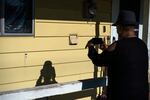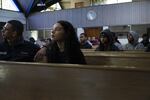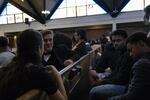Standing in his office adjacent to the Portland Police Bureau’s North Precinct, Roy Moore is explaining how gentrification has escalated some instances of gang violence in the neighborhood.
“We kinda had territories and codes, so I’m not going to go over there unless it’s time to do something,” he explained. “Now, it might happen anywhere. Twelve in the morning, nine in the morning going to get my blunt paper. I need my pistol with me now because I don’t know who I’m going to run into.”
Moore used to be in a gang. But today, he’s focused on his music and street level outreach with Antoinette Edwards, director of Portland’s Office of Youth Violence Prevention.
Edwards also grew up in North Portland, and said gentrification has eroded the community’s sense of belonging.
“And it's like, this is my hood but you're looking at me like I shouldn't be there,” Edwards said.
Community Rupture
In the early 2000s, North Portland rapidly gentrified. A long history of discouraging home ownership for the mostly black residents and then a development boom meant a huge number of the residents were priced out.
As microbreweries and artisanal donut shops popped up all over, something else was happening, too. The predominantly black community who had lived there for more than half a century was being pushed out.
“If you build that high-rise and I can't come up out of the basement and there's no room for me anymore, it's like I'm misplaced and I'm displaced,” Edwards said.
When community and opportunity disappear, problems like gang violence can get worse. Edwards’ work focuses on crime prevention and intervention, and she said “restorative justice” is one way to rebuild community.

Antoinette Edwards takes a photo of bullet holes in an elderly couple's North Portland home on Jan. 30, 2019, in North Portland, Ore.
Jonathan Levinson / OPB
Restorative justice doesn’t simply treat a crime as a law violation, it considers it an offense against the community. At its core is the principle that one's actions have a very real impact on the people one lives with and interacts with on a daily basis. Edwards said the goal of restorative justice is to heal “the harm that I’ve done.”
“It’s acknowledging my piece that I'm accountable,” Edwards said. “And your willingness to acknowledge, to honor that and to do what you need to do in collaboration and cooperation with the person and the victim that you've harmed.”
That could be an apology or community service. It could also be participating in dialogue, listening and being heard.
Restorative Justice Today
The practice's modern incarnation started in 1974 when Mark Yantzi, a probation officer in Canada, brought two teenagers responsible for a vandalism spree together to meet their victims. They went up and down the street, apologizing to the affected residents and hearing the impact. One man had bought a dog so he could feel safe again, another was in a lengthy insurance battle as a result.
Today, restorative justice is being used in cities like Oakland and Chicago, where gun violence has been a problem for years. But the idea is much older. Indigenous communities around the world have practiced variations of restorative justice for millennia.
Conversations about how to build and heal community are happening in churches and community centers in North Portland.
Restorative justice is usually reactive. Something happens – a shooting, a robbery – and the victim and perpetrator are brought together to undo the harm. But it can be proactive, too.
Expanding The Conversation
Herman Greene is the pastor at Portland's Abundant Life Church and a program director at the I Am Academy, a Portland program to help foster positive self-identity for black youth.
Edwards, Greene and Greene's wife, Nike, are using a restorative justice approach to address things like racism and culture bubbles. They said those are the underlying issues that keep causing the same results: harmful gentrification, lack of opportunity and gang violence.
Greene said the new residents in his neighborhood are still part of his community, even if they don’t look like him. And they also have to be part of the solution.
“I'm not blaming you for the problem,” he said. “But you are a byproduct of the system that is in place that reinforces gentrification.”
And changing that system means expanding the conversation.
In April, the mostly white Camas High School Choir came from Washington state to the Bethel AME Church in North Portland and performed "Seven Last Words," a choir piece using the last words of seven unarmed black people who were killed by police or authority figures, including Eric Garner, Amadou Diallo and Trayvon Martin.
They performed for mostly black students from Portland’s Roosevelt and Jefferson High Schools. This is part of a longer conversation the two communities have been having. In the weeks before the performance, the Roosevelt and Jefferson students went to Camas, and students from both schools had a chance to talk about their lives.

Students from Roosevelt and Jefferson High Schools listen to the Camas High School Men's Choir perform Seven Last Words on April 26, 2019, at the Bethel AME Church in North Portland, Ore.
Jonathan Levinson / OPB
Greene’s daughter, Taylor, was one of the students who went. She’s a junior at Roosevelt High School in Portland and said walking into Camas High School the first time, with its huge staircases and restaurants in the building, was uncomfortable.
“Versus we have to walk to McDonald's, that's like down the street,” she said.
Not only did she feel like she didn’t really belong there, but at first it felt like the white students just wanted to hear stories about black pain.
“I was kind of like, ‘Oh great, here's more white people wanting to hear our story,’” she recalled.
But after three meetings between the groups, she thinks the conversations are bearing fruit.
“We are slowly being able to get people to really understand,” she said.
Other people in the audience agreed. After the choir performance, the students broke into small groups and were given conversation prompts to further their discussion.
One prompt asked, “How does art play a role in social justice and community healing?”
“Art is an essential piece of the healing process,” came an answer from from a man in the back row. “As we just saw when they were singing, they just learned about this stuff but they could feel it.”

Students from Roosevelt and Jefferson High Schools speak with students from the Camas High School Men's Choir after the choir performed Seven Last Words on April 26, 2019, at the Bethel AME Church in North Portland, Ore.
Jonathan Levinson / OPB
These conversations are starting points for empathy and community, but they’re a small step in a huge problem. Greene said a strong community goes a long way to preventing violence, but it means everyone has to take ownership and invest.
“It’s your job to do whatever you can do to keep your community safe for your kids,” he said. “If that means you have to go out and say hello to people you wouldn’t normally say hello to, then you gotta go out and say hello.”
Standing alone in the chapel after all the students and organizers had left, Taylor Greene wanted to know what happens when everyone goes back to their mostly white bubble.
“Are you going to continue this conversation at lunch, or would we have to be there for that conversation to happen?” she asked.
Guns & America is a public media reporting project on the role of guns in American life.

